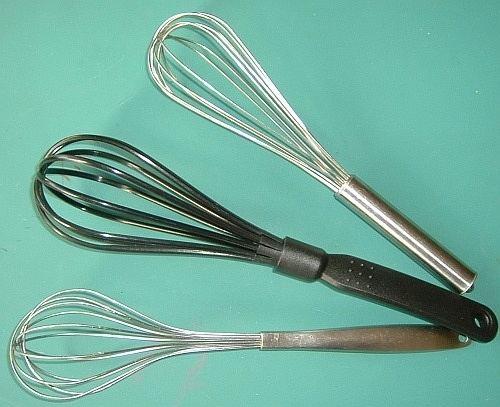A whisk is a cooking utensil which can be used to blend ingredients smooth, or to incorporate air into a mixture, in a process known as whisking or whipping. Most whisks consist of a long, narrow handle with a series of wire loops joined at the end. The wires are usually metal, but some are plastic for use with nonstick cookware. Whisks are also made from bamboo.
Whisks are commonly used to whip egg whites into a firm foam to make meringue, or to whip cream into whipped cream.
Whisks have differently-shaped loops depending on their intended functions:
Bundles of twigs, typically apple, have long been used as whisks; often the wood used would lend a certain fragrance to the dish. An 18th century Shaker recipe calls to “Cut a handful of peach twigs which are filled with sap at this season of the year. Clip the ends and bruise them and beat the cake batter with them. This will impart a delicate peach flavor to the cake.”
The wire whisk was invented by the Victorians in the 19th century, however, they were not in common use until Julia Child used one in her first ever televised appearance, in 1963. The television broadcast was on the television show "I've been Reading" to promote her new book “Mastering the Art of French Cooking.”
The most common shape is that of a wide teardrop, termed a balloon whisk. Balloon whisks are best suited to mixing in bowls, as their curved edges conform to a bowl's concave sides.With longer, narrower wire loops, the French whisk has a more cylindrical profile, suiting it to deep, straight-sided pans.A flat whisk, sometimes referred to as a roux whisk, has the loops arranged in a flat successive pattern. It is useful for working in shallow vessels like skillets (in which a roux is normally prepared).A gravy whisk, sometimes referred to as a spiral whisk, commonly has one main loop with another wire coiled around it. The angle of the whisk head is ideal for mixing gravy, jello, batters and sauces.Similarly, a twirl whisk or a coil whisk has one single wire that is spiralled into a balloon shape. Designed to remain stationary in a bowl while the user pumps the handle up and down, it circulates liquids readily throughout a bowl. It is not suitable for whisking in the traditional sense, since dragging the whisk through a liquid or batter simply stretches out the coils, but is ideal for beating eggs.Ball whisks have no loops whatsoever. Instead, a group of individual wires comes out of the handle, each tipped with a metal ball. The heavy balls are capable of reaching into the corners of a straight-sided pan. Since there are no crossing wires, the ball whisk is easier to clean than traditional looped varieties. Manufacturers of ball whisks also purport that their shape allows for better aeration.A cage whisk, sometimes referred to as a ball whisk, is a balloon whisk with a small spherical cage trapped inside of it, which in turn holds a metal ball.Since the 19th century, various mechanical devices have been designed to make whisking more efficient, under the names "egg beater", "rotary mixer", etc.

